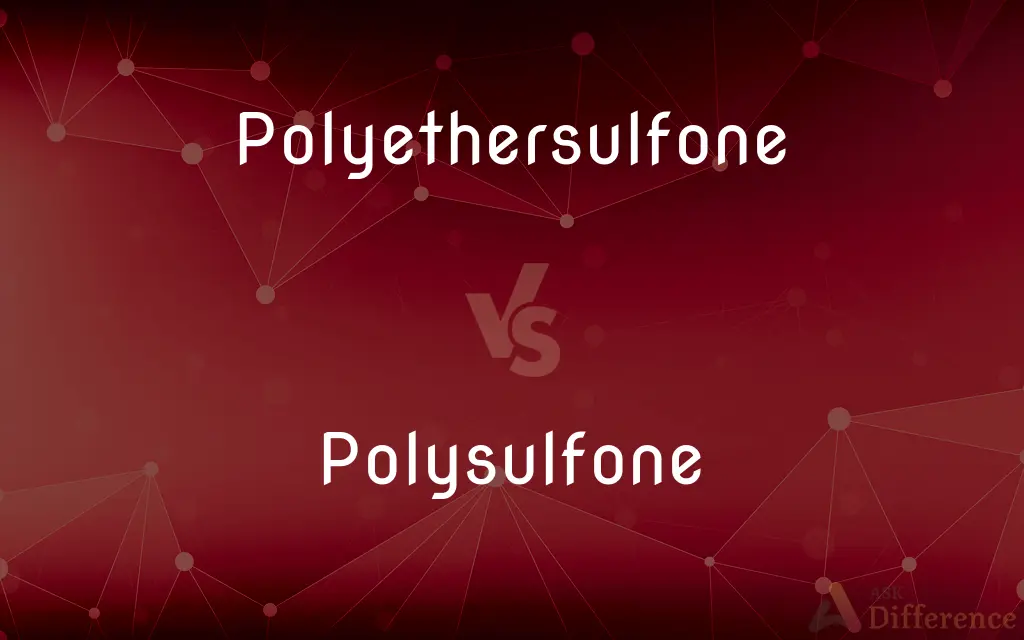Polyethersulfone vs. Polysulfone — What's the Difference?
By Urooj Arif & Fiza Rafique — Updated on March 21, 2024
Polyethersulfone (PES) offers higher temperature resistance and toughness compared to polysulfone (PSU), which is known for good thermal and mechanical stability.

Difference Between Polyethersulfone and Polysulfone
Table of Contents
ADVERTISEMENT
Key Differences
Polyethersulfone (PES) is recognized for its exceptional heat resistance, allowing it to perform in higher temperature environments where many plastics would fail. This characteristic, combined with its toughness, makes it suitable for demanding applications. On the other hand, polysulfone (PSU) also possesses good thermal stability but operates within a slightly lower temperature range than PES. While PSU is tough and durable, PES tends to offer better performance in extreme conditions.
Both PES and PSU exhibit excellent chemical resistance, making them ideal for use in medical and food service applications. However, PES generally provides a broader chemical resistance, extending its utility in harsher chemical environments. Conversely, PSU, while still resistant, may not perform as well under the same conditions, limiting its application scope.
In terms of processing, both materials can be challenging due to their high melting points. However, PES often requires more specialized processing conditions because of its higher melting temperature and inherent material properties. This can make PES components more expensive to manufacture than those made from PSU, affecting the overall cost-effectiveness of a project.
Optically, PES usually offers better transparency compared to PSU. This makes PES more suitable for applications where clarity is crucial, such as in medical devices and certain types of filtration equipment. PSU, while still used in applications requiring visibility, does not provide the same level of optical clarity.
The environmental resistance of PES is generally superior to that of PSU, particularly in terms of UV resistance and long-term stability under exposure to various elements. This makes PES a better choice for outdoor applications or any use case where the material will be exposed to harsh environmental conditions over long periods.
ADVERTISEMENT
Comparison Chart
Temperature Resistance
Higher, for extreme conditions
Good, but lower than PES
Chemical Resistance
Broader range
Good, but less broad than PES
Processing Difficulty
More challenging, higher costs
Less challenging, relatively cheaper
Optical Clarity
Better transparency
Less transparent
Environmental Resistance
Superior, including UV resistance
Good, but not as robust as PES
Compare with Definitions
Polyethersulfone
Exhibits excellent chemical resistance.
PES filters are employed in aggressive chemical environments.
Polysulfone
A thermoplastic known for thermal and mechanical stability.
PSU is used in automotive parts for its stability.
Polyethersulfone
A high-temperature engineering plastic.
PES is used in aerospace components for its heat resistance.
Polysulfone
Easier to process than higher melting point plastics.
PSU components are commonly found in consumer electronics.
Polyethersulfone
Known for its toughness and stability.
Medical devices often utilize PES for its durability.
Polysulfone
Offers good resistance to heat and chemicals.
Food service equipment utilizes PSU for its safety and durability.
Polyethersulfone
Requires specific processing due to high melting point.
Specialized equipment is needed to mold PES parts.
Polysulfone
Provides reliable performance in many environments.
PSU housing is used for outdoor electrical equipment.
Polyethersulfone
Suitable for applications needing high clarity.
Transparent PES is used in medical tubing and devices.
Polysulfone
Used in applications requiring some level of transparency.
PSU is chosen for water filtration systems for visibility.
Polyethersulfone
(chemistry) Any of a family of thermoplastic polymers that are known for their toughness and stability at high temperatures. They contain the subunit aryl-SO2-aryl, the defining feature of which is the sulfone group.
Polysulfone
Polysulfones are a family of high performance thermoplastics. These polymers are known for their toughness and stability at high temperatures.
Polysulfone
(chemistry) Any of a several classes of thermoplastic polymers whose repeat units contain a sulfone
Common Curiosities
Can both PES and PSU be used in medical applications?
Yes, both are used in medical applications due to their excellent chemical resistance and stability, though PES is often preferred for more critical applications.
What sets PES apart from PSU in high-temperature applications?
PES can withstand higher temperatures than PSU, making it suitable for extremely demanding environments.
Which material is more environmentally resistant?
PES has superior environmental resistance, including better UV stability, making it ideal for long-term outdoor applications.
Can PES and PSU be used in food contact applications?
Yes, both materials are suitable for food contact applications, adhering to regulations due to their chemical resistance and stability.
How does the cost of PES compare to PSU?
PES typically costs more than PSU, partly due to its superior properties and the more complex processing required.
How do processing differences impact the use of PES and PSU?
The more complex processing of PES can lead to higher costs, influencing the choice based on budget and application requirements.
Why might one choose PSU over PES?
PSU may be chosen over PES for its cost-effectiveness and sufficient performance in applications not requiring the extreme properties of PES.
How do the optical properties of PES and PSU compare?
PES offers better transparency than PSU, making it more suitable for applications where clear visibility is crucial.
How do the mechanical properties of PES and PSU compare?
Both PES and PSU have excellent mechanical properties, but PES's higher temperature resistance often gives it an edge in demanding applications.
What are the key industries that utilize PES and PSU?
Key industries include aerospace, automotive, medical, and food service for their high-performance applications.
What role does optical clarity play in selecting between PES and PSU?
Applications requiring clear visibility, such as medical devices, may benefit more from PES's superior optical clarity.
Why is environmental resistance important in choosing materials?
Environmental resistance determines a material's longevity and performance in outdoor or harsh conditions.
What are the limitations of using PSU in outdoor applications?
PSU's limited UV resistance compared to PES may affect its performance and durability in outdoor applications.
Are PES and PSU recyclable?
Both PES and PSU can be recycled, though the recycling process is complex and requires specific conditions.
How does chemical resistance affect the choice between PES and PSU?
PES's broader chemical resistance makes it preferable in environments exposed to harsher chemicals.
Share Your Discovery

Previous Comparison
Conch vs. Whelk
Next Comparison
Needy vs. ClingyAuthor Spotlight
Written by
Urooj ArifUrooj is a skilled content writer at Ask Difference, known for her exceptional ability to simplify complex topics into engaging and informative content. With a passion for research and a flair for clear, concise writing, she consistently delivers articles that resonate with our diverse audience.
Co-written by
Fiza RafiqueFiza Rafique is a skilled content writer at AskDifference.com, where she meticulously refines and enhances written pieces. Drawing from her vast editorial expertise, Fiza ensures clarity, accuracy, and precision in every article. Passionate about language, she continually seeks to elevate the quality of content for readers worldwide.
















































